英语论文-文化背景知识和翻译
- 格式:doc
- 大小:95.50 KB
- 文档页数:13

本科毕业论文英文翻译翻译是使用不同语言的民族之间交流思想、传递文化的一种手段。
下文是店铺为大家整理的关于本科毕业论文英文翻译的范文,欢迎大家阅读参考!本科毕业论文英文翻译篇1浅谈翻译里的中西方文化差异及其影响摘要:翻译与语言文化密不可分。
由于语言的民族性、地域性和时代性,翻译过程中往往会出现语言文化的差异。
英汉文化差异决定了英汉两种语言的不同特点。
本文从哲学和思维等方面比较了中西方文化的差异,指出翻译之本就在于跨越文化的障碍,翻译思维最重要的是文化思维。
关键词:翻译文化差异影响交流Abstract: Translation and language and culture are inseparable. Due to the language of the national character, Region and Time, the translation process tends to differences in language and culture. Cultural Differences between Chinese and determine the different characteristics of the two languages English and Chinese. This article compares the differences in Western culture from the philosophy and thinking, pointed out that the translation of this lies in the cross-cultural barriers, translation thinking is the most important cultural thinking.Key words: Translation Cultural differences Affect Exchange引言翻译,英文Translation,是指在准确通顺的基础上,把一种语言信息转变成另一种语言信息的行为。

发表英文翻译论文语言是人类传播信息的工具,作为各种语言互译的翻译理论本身就是一种是相对的理论。
下文是店铺为大家整理的关于发表英文翻译论文的范文,欢迎大家阅读参考!发表英文翻译论文篇1公示语的英文翻译摘要:公示语是一种较为独特的应用文体, 旨在于公共场所向公众公示须知的内容。
然而, 目前国内公示语的英译问题十分严重。
通过奈达的"功能对等"理论, 以中西文化差异在公示语中的体现为视角, 强调公示语的特点决定了其英译应重视功能上的对等而不是字词句上简单生硬的静态对等, 遵循正确的翻译原则,以实现公示语的预期功能。
关键词:公示语功能对等文化差异翻译原则1、引言公示语指的是在公共场所向公众公示须知内容的语言, 包括标识、指示牌、路牌、标语、公告、警示等等[1]。
罗选民、黎土旺对公示语进行界定, “公示语是指在公共场合所展示的文字, 具有特殊的交际功能, 以及提供信息和完成指令的作用”[2]。
随着中国与世界的接轨, 越来越多的国家希望了解中国, 很多外国朋友来到中国。
在这种跨文化交际的过程中, 汉语公示语的英译也日显重要。
然而, 目前国内公示语的英译问题十分严重, 误用、滥用现象到处存在,其中最大的问题是译者在翻译过程中忽视中西方文化的差异, 盲目追求字词句上简单生硬的静态对等, 以至于译文文本生硬, 达不到源语文本的预期功能和效果。
公示语英译的预期对象是在华外国友人和外国游客, 为的是达到向其警示、告知、宣传的预期功能。
其英译不是一种点缀, 而是一种有目的的行为, 即如何使译文达到与原文本同等的预期功能[3]。
本文通过奈达的“功能对等”理论, 以中西文化差异在公示语中的体现为视角, 强调公示语的功能特点决定了其英译应重视功能上的对等而不是字词句上简单生硬的静态对等, 应遵循正确的翻译原则,以实现其预期功能。
2、“功能对等”翻译理论与公示语翻译公示语作为一个信息时代和经济全球化时代的标志之一, 公开面对公众, 给予公众行为需求的文字信息传递。
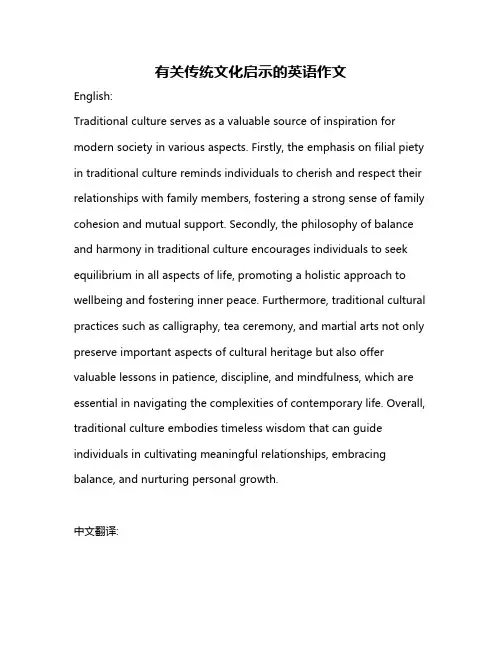
有关传统文化启示的英语作文English:Traditional culture serves as a valuable source of inspiration for modern society in various aspects. Firstly, the emphasis on filial piety in traditional culture reminds individuals to cherish and respect their relationships with family members, fostering a strong sense of family cohesion and mutual support. Secondly, the philosophy of balance and harmony in traditional culture encourages individuals to seek equilibrium in all aspects of life, promoting a holistic approach to wellbeing and fostering inner peace. Furthermore, traditional cultural practices such as calligraphy, tea ceremony, and martial arts not only preserve important aspects of cultural heritage but also offer valuable lessons in patience, discipline, and mindfulness, which are essential in navigating the complexities of contemporary life. Overall, traditional culture embodies timeless wisdom that can guide individuals in cultivating meaningful relationships, embracing balance, and nurturing personal growth.中文翻译:传统文化在各个方面为现代社会提供了宝贵的启示。

英语专业毕业论文综述英语专业毕业论文综述随着全球化的发展和国际交流的增加,英语专业的学生数量也逐渐增多。
英语专业毕业论文作为学生毕业的重要一环,对于学生的综合能力和专业素养有着重要的考验和锻炼。
本文将对英语专业毕业论文的相关研究进行综述,以期为今后的研究提供一定的参考和借鉴。
一、英语专业毕业论文的研究背景英语专业毕业论文的研究背景主要包括学科背景、社会背景和教育背景。
在学科背景方面,英语专业毕业论文的研究涉及到语言学、文学、翻译等多个学科的交叉融合。
在社会背景方面,全球化的发展和国际交流的增加使得英语专业人才的需求日益增加,因此英语专业毕业论文的研究具有重要的实际意义。
在教育背景方面,高等教育的普及和英语专业教育的改革使得英语专业毕业论文的研究成为英语专业学生毕业必备的一项任务。
二、英语专业毕业论文的研究内容英语专业毕业论文的研究内容主要包括语言学、文学、翻译等方面的研究。
在语言学方面,英语专业毕业论文的研究可以涉及到语音、语法、词汇、语用等多个层面。
在文学方面,英语专业毕业论文的研究可以涉及到英美文学、英语国家文化等方面的研究。
在翻译方面,英语专业毕业论文的研究可以涉及到翻译理论、翻译实践等方面的研究。
此外,英语专业毕业论文的研究还可以涉及到跨文化交际、教育语言学、应用语言学等方面的研究。
三、英语专业毕业论文的研究方法英语专业毕业论文的研究方法主要包括文献研究、实证研究和实践研究。
在文献研究方面,英语专业毕业论文的研究可以通过查阅相关文献资料,对已有的研究成果进行整理和总结。
在实证研究方面,英语专业毕业论文的研究可以通过实地调查、问卷调查等方法,对相关问题进行实证分析。
在实践研究方面,英语专业毕业论文的研究可以通过实践活动,对相关问题进行实践探索和验证。
四、英语专业毕业论文的研究价值英语专业毕业论文的研究价值主要体现在学术价值、实践价值和教育价值方面。
在学术价值方面,英语专业毕业论文的研究可以为相关学科的理论研究提供新的思路和方法。
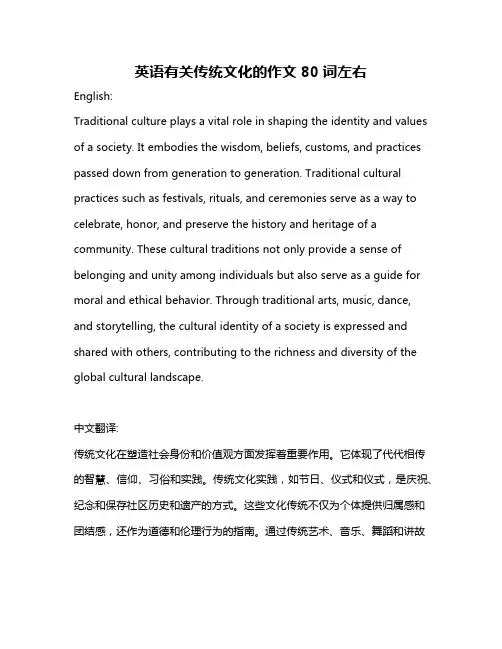
英语有关传统文化的作文80词左右English:Traditional culture plays a vital role in shaping the identity and values of a society. It embodies the wisdom, beliefs, customs, and practices passed down from generation to generation. Traditional cultural practices such as festivals, rituals, and ceremonies serve as a way to celebrate, honor, and preserve the history and heritage of a community. These cultural traditions not only provide a sense of belonging and unity among individuals but also serve as a guide for moral and ethical behavior. Through traditional arts, music, dance, and storytelling, the cultural identity of a society is expressed and shared with others, contributing to the richness and diversity of the global cultural landscape.中文翻译:传统文化在塑造社会身份和价值观方面发挥着重要作用。
它体现了代代相传的智慧、信仰、习俗和实践。
传统文化实践,如节日、仪式和仪式,是庆祝、纪念和保存社区历史和遗产的方式。
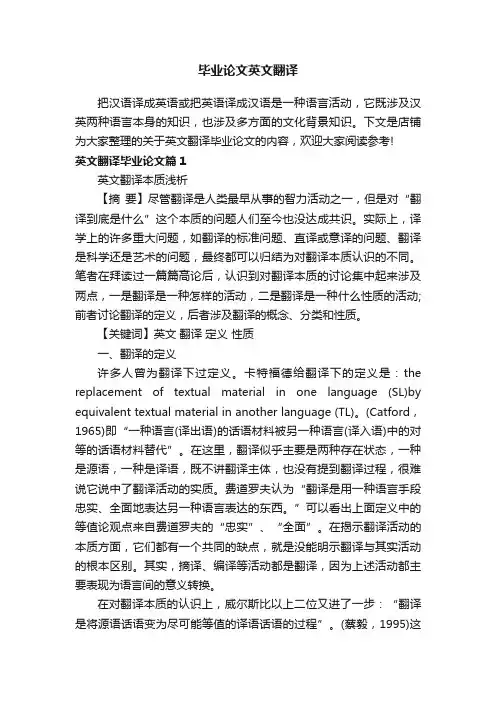
毕业论文英文翻译把汉语译成英语或把英语译成汉语是一种语言活动,它既涉及汉英两种语言本身的知识,也涉及多方面的文化背景知识。
下文是店铺为大家整理的关于英文翻译毕业论文的内容,欢迎大家阅读参考!英文翻译毕业论文篇1英文翻译本质浅析【摘要】尽管翻译是人类最早从事的智力活动之一,但是对“翻译到底是什么”这个本质的问题人们至今也没达成共识。
实际上,译学上的许多重大问题,如翻译的标准问题、直译或意译的问题、翻译是科学还是艺术的问题,最终都可以归结为对翻译本质认识的不同。
笔者在拜读过一篇篇高论后,认识到对翻译本质的讨论集中起来涉及两点,一是翻译是一种怎样的活动,二是翻译是一种什么性质的活动;前者讨论翻译的定义,后者涉及翻译的概念、分类和性质。
【关键词】英文翻译定义性质一、翻译的定义许多人曾为翻译下过定义。
卡特福德给翻译下的定义是:the replacement of textual material in one language (SL)by equivalent textual material in another language (TL)。
(Catford,1965)即“一种语言(译出语)的话语材料被另一种语言(译入语)中的对等的话语材料替代”。
在这里,翻译似乎主要是两种存在状态,一种是源语,一种是译语,既不讲翻译主体,也没有提到翻译过程,很难说它说中了翻译活动的实质。
费道罗夫认为“翻译是用一种语言手段忠实、全面地表达另一种语言表达的东西。
”可以看出上面定义中的等值论观点来自费道罗夫的“忠实”、“全面”。
在揭示翻译活动的本质方面,它们都有一个共同的缺点,就是没能明示翻译与其实活动的根本区别。
其实,摘译、编译等活动都是翻译,因为上述活动都主要表现为语言间的意义转换。
在对翻译本质的认识上,威尔斯比以上二位又进了一步:“翻译是将源语话语变为尽可能等值的译语话语的过程”。
(蔡毅,1995)这里没有硬性规定,只是说“尽可能等值”。
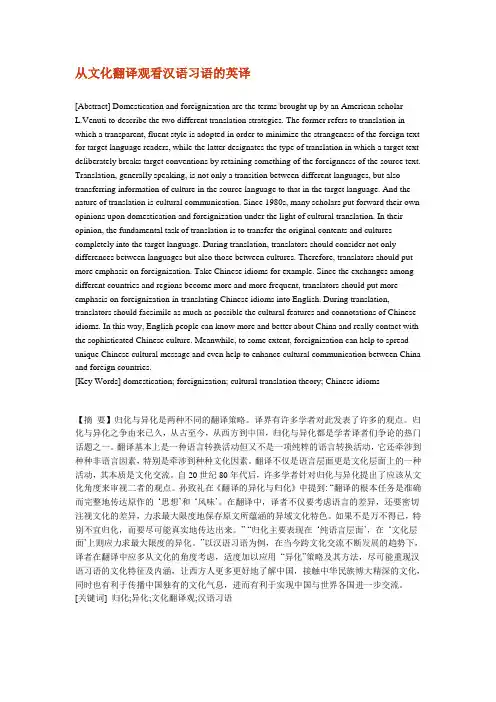
从文化翻译观看汉语习语的英译[Abstract] Domestication and foreignization are the terms brought up by an American scholarL.Venuti to describe the two different translation strategies. The former refers to translation in which a transparent, fluent style is adopted in order to minimize the strangeness of the foreign text for target language readers, while the latter designates the type of translation in which a target text deliberately breaks target conventions by retaining something of the foreignness of the source text. Translation, generally speaking, is not only a transition between different languages, but also transferring information of culture in the source language to that in the target language. And the nature of translation is cultural communication. Since 1980s, many scholars put forward their own opinions upon domestication and foreignization under the light of cultural translation. In their opinion, the fundamental task of translation is to transfer the original contents and cultures completely into the target language. During translation, translators should consider not only differences between languages but also those between cultures. Therefore, translators should put more emphasis on foreignization. Take Chinese idioms for example. Since the exchanges among different countries and regions become more and more frequent, translators should put more emphasis on foreignization in translating Chinese idioms into English. During translation, translators should facsimile as much as possible the cultural features and connotations of Chinese idioms. In this way, English people can know more and better about China and really contact with the sophisticated Chinese culture. Meanwhile, to some extent, foreignization can help to spread unique Chinese cultural message and even help to enhance cultural communication between China and foreign countries.[Key Words] domestication; foreignization; cultural translation theory; Chinese idioms【摘要】归化与异化是两种不同的翻译策略。
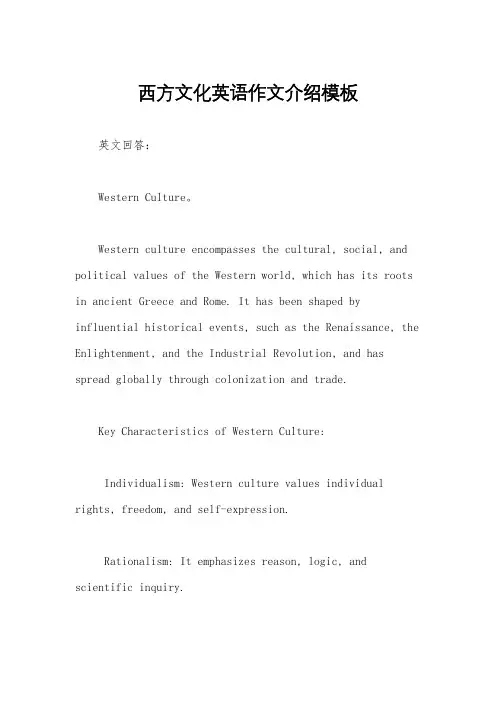
西方文化英语作文介绍模板英文回答:Western Culture。
Western culture encompasses the cultural, social, and political values of the Western world, which has its roots in ancient Greece and Rome. It has been shaped byinfluential historical events, such as the Renaissance, the Enlightenment, and the Industrial Revolution, and has spread globally through colonization and trade.Key Characteristics of Western Culture:Individualism: Western culture values individual rights, freedom, and self-expression.Rationalism: It emphasizes reason, logic, andscientific inquiry.Secularism: Western culture generally separatesreligion from the state and promotes tolerance of different beliefs.Democracy: It values representative government, civil liberties, and human rights.Materialism: Western culture places importance on economic growth, technological advancement, and consumerism.Influence of Western Culture:Western culture has had a profound impact on global affairs. It has:Shaped political systems and economic models worldwide.Influenced art, music, literature, and cinema.Spread scientific and technological advancements.Promoted human rights and civil liberties.Challenges to Western Culture:In recent decades, Western culture has faced challenges, including:Globalization and multiculturalism.The rise of fundamentalism and authoritarianism.Economic inequality and environmental degradation.中文回答:西方文化。

关于英语翻译方向的论文范文翻译在跨文化、跨民族之间的交流和合作中功不可没,英语翻译,它既是语言之间的相互转换,同时也是不同文化间的交流。
下文是店铺为大家整理的英语翻译的论文的范文,欢迎大家阅读参考!英语翻译的论文篇1文化空缺与英汉翻译摘要:不同民族的语言产生于不同的文化背景,所承载的文化也不尽相同,这就必然导致两种语言在表达方式上存在很多相异之处,文化空缺就是这些差异的极端表现,它是一个民族语言和文化与其它民族语言和文化的异质性的充分体现,这无疑增加了翻译的难度。
所以文化空缺的翻译不仅是语言的迁移,更是文化的传播。
关键词:文化空缺英汉翻译翻译作为人类最早进行的交流活动之一,一直在不同的语言集团间沟通信息,对人类社会的发展和进步有非常重要的作用。
正是由于翻译所起的中介作用,民族间才可以互通有无、互相学习、共同发展。
跨文化交际学和文化语言学的兴起与发展,为语言与文化的研究带来了勃勃生机。
而作为跨文化交际的翻译,也因此而更加受到重视,对它的研究也呈现出多角度、多侧面、开放性的特点。
翻译作为不同语言之间人们交流思想和文化不可或缺的手段,在传播文化信息、促进不同民族间的相互了解与民族融合的过程中的重要作用已日益凸显。
翻译界对翻译理论研究的重心从译意到译信息再到以文化为导向的翻译,正说明翻译实质是文化的翻译。
如Bassnet & Lefevele就指出翻译的研究实际上就是文化互动的研究,Nida亦强调译者的双文化能力。
而在交流与翻译活动过程中,各民族由于语言文化异质性的客观存在,会不可避免地出现信息交流的障碍。
其中作为语言文化异质性极致体现形式的文化空缺现象更使交流者进入了两难的境地。
为积极应对空缺现象带来的问题,促使交流与翻译的顺利进行,就必须在交流与翻译过程中逐步探寻处理文化空缺的有效途径和办法。
翻译,在古时候叫做“象寄”或“通事”。
《说文解字》里说:“传译四夷之言者。
”《义疏》里也提到:“译即易,谓换易言语使相解也。
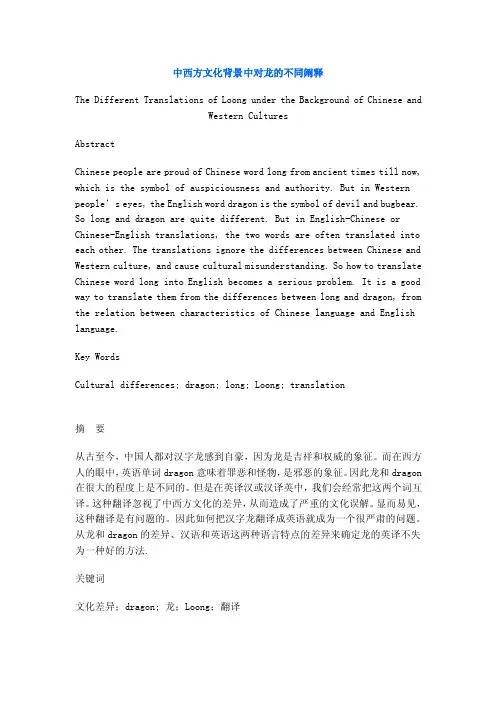
中西方文化背景中对龙的不同阐释The Different Translations of Loong under the Background of Chinese andWestern CulturesAbstractChinese people are proud of Chinese word long from ancient times till now, which is the symbol of auspiciousness and authority. But in Western people’s eyes, the English word dragon is the symbol of devil and bugbear. So long and dragon are quite different. But in English-Chinese or Chinese-English translations, the two words are often translated into each other. The translations ignore the differences between Chinese and Western culture, and cause cultural misunderstanding. So how to translate Chinese word long into English becomes a serious problem. It is a good way to translate them from the differences between long and dragon, from the relation between characteristics of Chinese language and English language.Key WordsCultural differences; dragon; long; Loong; translation摘要从古至今,中国人都对汉字龙感到自豪,因为龙是吉祥和权威的象征。
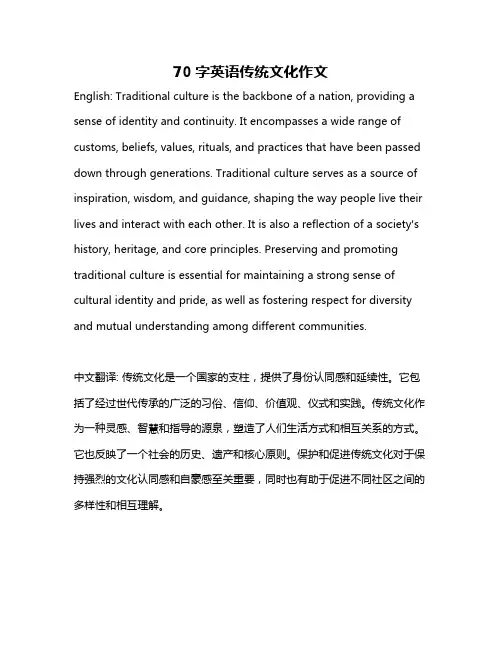
70字英语传统文化作文English: Traditional culture is the backbone of a nation, providing a sense of identity and continuity. It encompasses a wide range of customs, beliefs, values, rituals, and practices that have been passed down through generations. Traditional culture serves as a source of inspiration, wisdom, and guidance, shaping the way people live their lives and interact with each other. It is also a reflection of a society's history, heritage, and core principles. Preserving and promoting traditional culture is essential for maintaining a strong sense of cultural identity and pride, as well as fostering respect for diversity and mutual understanding among different communities.中文翻译: 传统文化是一个国家的支柱,提供了身份认同感和延续性。
它包括了经过世代传承的广泛的习俗、信仰、价值观、仪式和实践。
传统文化作为一种灵感、智慧和指导的源泉,塑造了人们生活方式和相互关系的方式。
它也反映了一个社会的历史、遗产和核心原则。
1000字的英语论文范文英语虽然不是母语但也是我们必须要学习的语言,下面是小编整理的英语论文范文,欢迎阅读借鉴。
1000字的英语论文范文1基于文化要素的商务英语口译策略0 引言英语是世界上公认的最为通用的语言,在任何正式或是非正式场合都需要英语作为基本的交流沟通工具。
来自不同国家,不同背景的人们在交流过程中能够使用一种通用语言就可以将彼此的思想用最简单直接的方式传达给对方。
尤其是在商务洽谈中,英语起着至关重要的作用。
同时对于商务英语口译人员也不断地提出更多适应性的要求。
面对不同文化背景的场合,能够领会其中要表达的中心思想还能将意思传达到另一种文化背景之下,这是也是对口译人员的一项挑战。
1 商务英语口译中的文化视角具有商务活动的特征是商务英语口译区别于其他英语口译工作者最主要的特点。
商务英语的口译者需面对不同文化背景的人,所以专业的商务英语口译人员要具备专业性的同时还要具有准确性和保密性。
随着大经贸、大商务格局的形成,口译已经不仅仅受限于以往的进出口、商务谈判、函电等方面,而是涵盖经济、金融、贸易、商法、营销等一切用于商务活动的场合。
由于商务活动本身就是一件专业性很强的活动,这对商务英语口译人员而言也是需要一定范围的专业性,不仅仅是语言的专业性,也要具备商业知识的专业性,例如。
商务规范、公司法规、商务合同等,都需要口译者具备一定的背景知识。
在实际口译过程中不仅需要口译人员现场将双方的中心思想流利地表达出来,更重要的是要有一定的准确性。
有时,由于口译人员一丁点的口语失误就可能造成重大的损失,尤其是牵扯到数学问题的时候。
因此,在翻译过程中考虑准确性的时候要同时考虑发音数字,做代表的立场专业术语等各方面的准确性。
很多商务活动中都会涉及一点商业机密,此种情况下,口译人员还要做到保密性,切记不可以将自己做代表的一方的商业文件泄漏出去,否则不仅使公司利益受损,对于口译人员自己而言不仅是专业素养的欠缺同时也会受到相关的法律惩罚。
中国传统文化英文范文English:Chinese traditional culture is rich and diverse, embodying the core values and beliefs that have been passed down through generations. One of the key aspects of Chinese traditional culture is filial piety, which emphasizes the respect and devotion that children should show towards their parents and ancestors. Another important element is Confucianism, with its emphasis on moral virtues, harmony, and social order. Chinese traditional culture also values reverence for the elderly, the importance of maintaining strong family ties, and the significance of rituals and ceremonies in daily life. Art forms such as calligraphy, painting, music, and poetry have long been revered in Chinese culture, reflecting the deep appreciation for aesthetics and craftsmanship. Traditional Chinese medicine, martial arts, and cuisine are also integral parts of Chinese traditional culture, showcasing the holistic approach to health and well-being. Overall, Chinese traditional culture provides a comprehensive understanding of the history, values, and practices that have shaped Chinese society for centuries.中文翻译:中国传统文化丰富多样,体现了代代相传的核心价值观念和信仰。
拟定一篇英语专业的论文提纲,就好像绘制建筑房子的蓝图一样,没有建筑师事先草拟蓝图,工人也就无法盖好一间令人满意的房子。
同样,写英语论文没有大纲的指引,任凭思想的奔驰,随意下笔,思绪容易错乱,甚至不知所云,本文为大家分享了2篇“英语专业本科论文提纲范文”,以供参考英语专业本科论文提纲一(英文版):论文题目:目的论视角下的金融英语翻译报告CONTENTSABSTRACT摘要1 Chapter One Introduction1.1 Background of the Translation1.2 Description of the Translation1.3 Framework2 Chapter Two Task Description2.1 TextualAnalysis2.1.1 The Lexical Features2.1.2 The Syntactic Features2.1.3 The Cultural Features2.2 Translation Procedures2.2.1 Preparation before Translation2.2.2 The Process of Translation2.2.3 Proofreading after Translation3 Chapter Three Theoretical Foundation of the Report3.1 Skopos Rule3.2 The Principle of Coherence3.3 The Principle of Fidelity4 Chapter Four CaseAnalysis4.1 Literal Translation Strategy4.1.1 The Reason of Using Literal Translation Strategy4.1.2 TheApplication of Literal Translation Strategy4.2 Contextual Translation Strategy4.2.1 The Reason of Using Contextual Translation Strategy 4.2.2 TheApplication of Contextual Translation Strategy4.3 Domesticating Translation Strategy4.3.1 The Reason of Using Domestication Translation Strategy4.3.2 TheApplication of Domesticating Translation Strategy5 Chapter Five Conclusion5.1 Summary5.2 Limitations and SuggestionsBIBLIOGRAPHYACKNOWLEDGEMENTSPUBLISHED PAPER英语专业本科论文提纲二(中文版):论文题目:《绝望的主妇》口译配音实证探讨目录摘要第一章绪论1.1研究动机1.2研究目的1.3研究范围1.4研究方法1.5论文结构第二章文献分析2.1关联理论的研究2.2口语背景的语言研究观2.3语意对等的口译观2.4口语口译研究第三章《绝望的主妇》语意关联成分探讨3.1情境喜剧《绝望的主妇》简介3.2人物特质和关联方式3.3言语关联语言分析3.4口译中的关联手法第四章《绝望的主妇》口译配音实证探讨4.1 口译合作原则4.2口译中的礼貌原则4.3口译言语行为准则研究4.3.1口语用语习惯4.3.2语法的正确表达4.3.3语意的精确表现4.3.4准确口译原文句子的意境第五章结论与建议5.1结论5.2研究应用5.3研究限制5.4未来研究方向参考文献致谢。
英语专业毕业论文翻译方向英语专业毕业论文翻译方向随着全球化的发展,英语专业毕业论文翻译方向成为越来越多学生选择的方向。
翻译作为一门语言学科,不仅需要掌握语言的基本知识,还需要具备一定的文化素养和专业背景。
本文将从翻译的定义、翻译方向的选择、翻译技巧和翻译的前景等方面进行探讨。
首先,翻译是将一种语言转化为另一种语言的过程。
翻译的目的是为了使不同语言之间的信息得以传递和理解。
翻译的难度在于不同语言之间的差异,包括语法、词汇、语义和语用等方面。
因此,翻译需要翻译者具备良好的语言能力和跨文化交际能力。
在选择翻译方向时,应根据个人的兴趣和专业背景进行选择。
英语专业毕业论文翻译方向可以包括文学翻译、商务翻译、法律翻译、科技翻译等。
文学翻译要求翻译者具备良好的文学素养和文化背景,能够准确传达原文的意境和风格。
商务翻译要求翻译者具备商务知识和跨文化交际能力,能够准确传达商务文件和会议内容。
法律翻译要求翻译者具备法律知识和专业术语的掌握,能够准确传达法律文件和合同条款。
科技翻译要求翻译者具备科技知识和专业术语的掌握,能够准确传达科技文献和研究成果。
在进行翻译时,需要掌握一些翻译技巧。
首先,要注意语言的准确性和流畅性。
翻译不仅要准确传达原文的意思,还要使译文符合目标语言的语法和习惯用法。
其次,要注意文化的适应性。
不同语言和文化之间存在差异,翻译者要根据目标读者的文化背景进行适当的调整。
再次,要注意上下文的理解和转化。
翻译不仅要理解句子的表面意思,还要理解句子的语境和语用功能,以便进行准确的转化。
英语专业毕业论文翻译方向具有广阔的前景。
随着全球化的深入发展,跨国公司和国际组织对翻译人才的需求越来越大。
翻译人才不仅可以从事翻译工作,还可以从事口译、笔译、翻译管理、翻译教学等相关工作。
同时,随着互联网的普及,网站翻译和软件翻译也成为热门的翻译方向。
因此,选择英语专业毕业论文翻译方向将为学生提供广阔的就业机会和发展空间。
总之,英语专业毕业论文翻译方向是一门既有挑战性又有前景的学科。
传统文化英文作文英文回答:Traditional culture plays a pivotal role in shaping our collective identities, fostering a sense of belonging, and providing a foundation for our values and beliefs. It encompasses the accumulated knowledge, practices, beliefs, and rituals that have been passed down through generations and are integral to the fabric of a society. Traditional culture serves as a repository of knowledge, helping us understand our past, present, and future while providing a sense of continuity and stability.One of the primary benefits of traditional culture is its ability to foster a sense of belonging. By sharing a common set of beliefs, practices, and values, individuals feel connected to their community and develop a strong sense of identity. This sense of belonging contributes to social cohesion, promoting cooperation and mutual respect among members of a society. It also serves as a source ofpride and self-esteem, giving individuals a sense of purpose and meaning within their community.Traditional culture also plays a crucial role in transmitting values and beliefs. Through stories, rituals, and practices, traditional culture teaches individuals about the importance of respect, compassion, honesty, and other core values. These values shape our moral compass and guide our actions, helping us make decisions that align with the ethical principles of our society. Traditional culture also provides a framework for understanding the world and our place within it, offering explanations for natural phenomena, social norms, and the meaning of life itself.Moreover, traditional culture serves as a source of creativity and innovation. By drawing inspiration from traditional practices, artists, musicians, and artisans create new works that reflect the spirit of their culture while also pushing the boundaries of creativity.Traditional culture provides a rich tapestry of motifs, symbols, and techniques that can be adapted andreinterpreted to create contemporary works of art and literature that resonate with both traditional and modern audiences.However, it is important to recognize that traditional culture is not static but rather a dynamic and evolving entity. As societies change and new ideas emerge, traditional culture adapts to reflect the changing needs and aspirations of its people. This process of adaptation ensures that traditional culture remains relevant and meaningful while preserving its core values and beliefs.中文回答:传统文化在塑造我们的集体认同、培养归属感以及为我们的价值观和信仰提供基础方面发挥着至关重要的作用。
文学文化英文作文英文:Literature and culture are two intertwined conceptsthat have a significant impact on our lives. Literature is a form of art that expresses the human experience through language, while culture refers to the shared beliefs, values, customs, behaviors, and artifacts that characterize a society.Literature plays a crucial role in shaping culture. It reflects and critiques the values and beliefs of a society, and it can also challenge and change them. For example, the works of Shakespeare have had a profound impact on English culture and language. His plays have become a cornerstone of English literature, and his language has influenced the way we speak and write today.On the other hand, culture also influences literature. The cultural context in which a work is produced can shapeits content and style. For instance, the works of Toni Morrison, a prominent African American writer, are deeply rooted in the African American experience and culture. Her novels explore issues such as race, identity, and history, and they are written in a style that reflects the rhythms and cadences of African American speech.中文:文学和文化是两个紧密相连的概念,对我们的生活有着重要的影响。
文化背景知识和翻译[Abstract] It is agreed that language is a component of culture and reflects it; translation is not only the linguistic but also the communication of cultures. Culture background knowledge is concerned with geographic chatacteristics,historical ,tradition, social customs ,religion arts and other aspects of a society. Also it conditions the psychological make-up of individuals. Therefore, target language readers may experience culture shock from translations do not properly deal with the factors of cultures as a result of their lack of cultural background knowledge, This paper discusses the influence of knowledge of cultures on translation, and concludes that translators should have a vast and precise understanding of the two cultures concerned.[Key Words] culture; translation; cultural background knowledge[摘要] 语言不仅是文化的组成部分,也是文化的反映形式。
翻译不仅仅是语言间的转换,而且是文化间的交流活动。
文化背景知识涉及历史、地理特征、传统、社会风俗、宗教、艺术以及社会的各个方面。
同时,文化背景知识也影响了社会成员的心理结构。
因此,如果翻译者缺乏文化背景知识并因此不能恰当处理好原文中的文化因素,译文读者可能要面对激烈的文化冲击。
本文将主要讨论译者文化背景知识对翻译的影响。
最后得出结论:翻译者应该对相关的两种文化都有广泛而深入的认识。
[关键词] 文化;翻译;文化背景知识1. IntroductionAccording to the tradition theory of translation, people considered translating activities as a process of transfer between two languages. In the 1970s, the study of translation tended to develop in several directions. It was no longer restricted to the tradition aesthetic and linguistic study and become cultural rethinking.According to the theories of Mary Snell-Hornby, Bassnett and Lefevere, we can conclude that translation is to present in another culture the meaning and implication that the text has in a specific cultural context. In nature, translation is a kind of communication between cultures. During the process of translation, the interpretation and expression of the connotation of culture emerge as problems to be solved at the first place. That requires the translators not only should have bilingual abilities but also should have the knowledge of two cultures of, even several cultures. In 1993, Nida pointed out that, for the truly successful translation, the knowledge of two cultures is more important than the bilingual ability. [1]E.B.Tylor, an anthropologist, thought culture is a complicated gathering, including knowledge, belief, arts, moral standards, law, customs and all the abilities and habits of individuals as members of a society.[2] The scope of culture is extremely wide-ranging .Language is the reflection of culture .Any kind of language bases on the ground of certain culture. So, the cultural characteristics of language include the way of thinking, psychological make-up, historical,tradition, social customs, believes and geographic features that the language reflects. To understand the source language and the original text, translators have to analyze those cultural characteristics of a language.2. Culture and languageCulture is a complicated system including and influencing almost all the aspects of life in a society. The language that the society uses is no exception. However, language also influences culture. Language and culture influences each other and reflects each other.2.1 Culture and languageE. B. Tylor, an anthropologist, said that culture is a complicated combination including knowledge, belief, arts, ethics, laws, customs and the ability and habits of individuals as members of a society. Here knowledge refers to academic subjects, both scientific and not scientific, for example, mathematics and linguistics. Belief could be divided into two sorts, political and religious, which are different among peoples and often course different comprehension and even conflicts. Examples are Christianity in the west countries and Islam in the Muslin countries. Arts comprise painting, architecture, sculpture, literature, opera, dancing, music etc. (Some people maintain that film is also a sort of the arts.) Ethics is a set of principles that people use to decide what is right and what is wrong.The scope of culture is not measurable. Language is a part of it. All languages grow on the ground of certain cultures.[3] Different languages are not just used, but also created in different cultural situations. Thus languages bear their characteristics in accordance with those of specific cultures. To understand the language appropriately, we have to analyze the cultural characteristics of it. Language is a system of sounds, words, patterns, ect used by human‟s to communicate thoughts and feelings. We begin our preview of language by noting that it is impossible to separate our use of language from our culture. In its most basic sense, language is a set of symbols and the rules for combining those symbols that are used and understood by a large community of people. When we study another language, we soon discover that not only are the symbols (words) and sounds for those symbols different, but also are the rules (phonology, grammar, syntax and intonation) for using those symbols and sounds.Word differences are obvious in various languages. In English, we live in a house. In Spanish, we live in a casa. In Tai, we live in a ban. Phonology also varies culturally. In English, we have 21 consonants and 5 vowels and combine to form 38 various phonemes. Vietnamese has 34 segmental phonemes consisting of vowels, semi-vowels and consonants. The Filipino language has 21 consonants and 13 vowels that form 26 phonemes. Grammatical structures are unique to each language as well. In English, we have singular and plural nouns and pronouns, but in Korean, the distinction between singular and plural is made by the context of the sentence. In English, verb tenses express contrast between past, present, and future acts, but in Vietnamese, the same verb reflects all three and the time of the action is inferred from the context. Syntax, or the word order and structure in the sentence, also varies depending on the language. The normal word order for simple sentences in Vietnamese is the reverse of the word order in English. That is, the predicate is followed by the subject. For example, the English sentence "The teacher died" would be"Namatay ang guro" or "Died the teacher" in Filipino. In English the subject is followed by a verb and then an object, but in Japanese, the subject is followed by the object and then the verb. So in English we might say, "John saw the dog." but in Japanese, "John the dog saw" would be correct.[4]These examples indicate that if we want to communicate in another language, it is important for us to know not only the symbols (words) of that language, but also the rules for using those symbols. As we know, language is much more than symbol and rule system that allow us to communicate with other person——language also shape the process by which people become introduced to the order of the physical and social environment.2.2 Relationship between language and cultureLanguage and culture influence each other, reflect each other and co-exist with each other. Different cultures result in different language. Different languages in turn cause different communicative patterns and finally differences between cultures.Language and its cultural influence are exemplified in the theoretical formulations of theSapir-Whorf hypothesis, which states that Sapir and Whorf believe that language filters people‟s perception and the way they categorize experiences. This hypothesis implies that proclaimed that the structure of the language people habitually use influences the ways they think and behave. That is to say, different languages offer people different ways of expressing the world around, they think and speak differently [5]. Sapir wrote: Human beings do not live in the objective world alone, nor in the world of social activity as ordinarily understood, but are very much at the mercy of the particular language which has become the medium of the expression of their society... The real world is to a large extent unconsciously built on the language habits of the group. No two languages are ever sufficiently similar to be considered as representing the same social reality. The worlds in which different societies live are distinct worlds, not merely the same world with different labels attached.A good illustration of this point is the word snow in Eskimo and English. The Eskimos have countless words for snow. For them snow is extremely important and so crucial to life that each of its various forms and conditions is named. In English-speaking cultures, snow is far less important and the simple word snow usually suffices the needs. When some needs become more specific, however, longer phrases can be made up to meet these needs: "corn snow", "fine powder snow ", and "drifting snow". Once again this proves that there is a connection between the words a culture selects and the ideas and things of that culture. In short, each culture presents to its members, either consciously or subconsciously through words, the ideas and concepts that culture transmits from generation to generation [6].Another instance of how language defines experience can be seen in the Navajo language, which emphasis the nature and the direction of movement. Rather than saying, "One dresses," the Navajo would say, one move into clothing." Instead of saying, "One is young," the Navajo would say, "One moves about newly." Language is one aspect of the Navajo nature that coincides with the notion of universe in motion.Although complete acceptance of the Sapir-Whorf hypothesis may be controversial, its application of culture and language is clear: language is the reflection of culture, and culture is a shape oflanguage. We have seen that culture influences language by way of symbols and rules as well as our perception of the universe. Equally important is the fact that meaning shifts from culture to culture.2.3 Different language and culture lead to different communicative patternChinese communication pattern and use of language are similar to those of Japanese and Koreans. The Chinese tend to be situation-oriented and to view events in relation to the totality. For the Chinese, this total view, an is-or-is-not polarity is avoided. In English, people and thing are placed in a continuum—big and small, good and bad, black and white. For the Chinese, middle values are articulated and a reciprocal relationship between the two extremes is emphasized. For example, the Chinese may refer to love and hate as deference and politeness, they would like to say:”我对她有点意思!”instead of “我爱她!”, and”我懒得理他!”instead of “我讨厌他!”. This focus on the quality of the continuum is a reflection of the Chinese belief in the principle of nature, yin (passive) and yang (active). This polite principle combines to produce everything that comes to be. It makes people more concordant and avoids the communication conflict.We have alluded to the fact that the use of direct and indirect language is a major linguistic difference between North Americans and many Asian cultures, such as the Chinese. Most North Americans learn to say yes and no as a means of expressing their individual views. Being a collective culture, the Chinese usually use yes and no to express the respect for the feeling of the others. In other words, to say yes for no or no for yes is largely a reflection of the indirect approach to communication. For example, Chinese and English have a different answer for “you are not a student, are you?” For the Chinese students, he will answer:“不,我是学生。